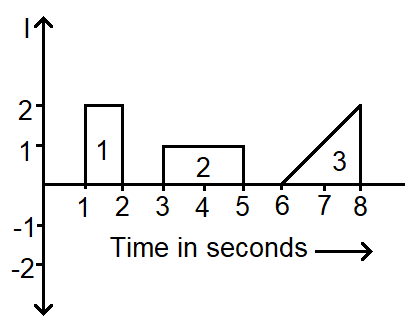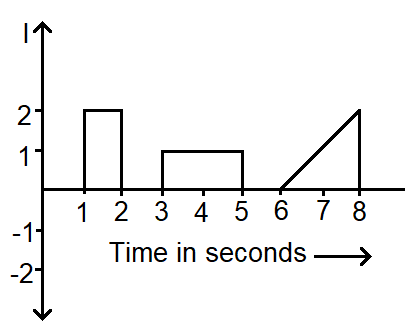Answer
405.3k+ views
Hint In a current v/s time plot, the charge is given by the area under the curve. So we can calculate the area under the curve at three different times and then by finding their ratio, we can find the charge flowing through the wire at three different times.
Formula Used: In this solution we will be using the following formula,
$\Rightarrow I = \dfrac{{dq}}{{dt}}$
where $I$ is the current in the wire,
$q$ is the charge flowing and $t$ is the time.
Complete step by step answer
In the question we are given the plot of the current flowing through a wire. Now the current in a wire and the charge flowing is related by the formula,
$\Rightarrow I = \dfrac{{dq}}{{dt}}$
Now taking the $dt$ from the denominator of the RHS to the LHS to get,
$\Rightarrow dq = Idt$
Therefore, in a plot of current and time, the charge will be given by the area under the curve. So let us name the 3 curves as 1, 2 and 3.

Now for the first plot, we can see that it is a rectangle.
According to the figure, the sides of the rectangle are $2A$ along the Y-axis and $1s$along the X-axis.
So we have the area as,
$\Rightarrow {A_1} = 2 \times 1 = 2C$
Now for the second plot, we can see that it is a rectangle.
According to the figure, the sides of the rectangle are $1A$ along the Y-axis and $2s$along the X-axis.
So we have the area as,
$\Rightarrow {A_2} = 1 \times 2 = 2C$
Now for the third plot, we can see that it is a triangle.
According to the figure, the height of the triangle is $2A$ along the Y-axis and the base is $2s$ along the X-axis.
So we have the area as,
$\Rightarrow {A_2} = \dfrac{1}{2} \times 2 \times 2 = 2C$
Therefore the ratio of the charges will be the ratio of the areas under the plot,
$\Rightarrow {A_1}:{A_2}:{A_3} = 2:2:2$
So the ratio is $1:1:1$
Hence the correct answer is option C.
Note
When there are charges moving through a wire, then a current is generated in the wire. Hence the rate of flow of charge through a wire per unit time is called the current in the wire. The unit of current in the wire is coulomb and it is denoted by the letter C.
Formula Used: In this solution we will be using the following formula,
$\Rightarrow I = \dfrac{{dq}}{{dt}}$
where $I$ is the current in the wire,
$q$ is the charge flowing and $t$ is the time.
Complete step by step answer
In the question we are given the plot of the current flowing through a wire. Now the current in a wire and the charge flowing is related by the formula,
$\Rightarrow I = \dfrac{{dq}}{{dt}}$
Now taking the $dt$ from the denominator of the RHS to the LHS to get,
$\Rightarrow dq = Idt$
Therefore, in a plot of current and time, the charge will be given by the area under the curve. So let us name the 3 curves as 1, 2 and 3.

Now for the first plot, we can see that it is a rectangle.
According to the figure, the sides of the rectangle are $2A$ along the Y-axis and $1s$along the X-axis.
So we have the area as,
$\Rightarrow {A_1} = 2 \times 1 = 2C$
Now for the second plot, we can see that it is a rectangle.
According to the figure, the sides of the rectangle are $1A$ along the Y-axis and $2s$along the X-axis.
So we have the area as,
$\Rightarrow {A_2} = 1 \times 2 = 2C$
Now for the third plot, we can see that it is a triangle.
According to the figure, the height of the triangle is $2A$ along the Y-axis and the base is $2s$ along the X-axis.
So we have the area as,
$\Rightarrow {A_2} = \dfrac{1}{2} \times 2 \times 2 = 2C$
Therefore the ratio of the charges will be the ratio of the areas under the plot,
$\Rightarrow {A_1}:{A_2}:{A_3} = 2:2:2$
So the ratio is $1:1:1$
Hence the correct answer is option C.
Note
When there are charges moving through a wire, then a current is generated in the wire. Hence the rate of flow of charge through a wire per unit time is called the current in the wire. The unit of current in the wire is coulomb and it is denoted by the letter C.
Recently Updated Pages
How many sigma and pi bonds are present in HCequiv class 11 chemistry CBSE

Why Are Noble Gases NonReactive class 11 chemistry CBSE

Let X and Y be the sets of all positive divisors of class 11 maths CBSE

Let x and y be 2 real numbers which satisfy the equations class 11 maths CBSE

Let x 4log 2sqrt 9k 1 + 7 and y dfrac132log 2sqrt5 class 11 maths CBSE

Let x22ax+b20 and x22bx+a20 be two equations Then the class 11 maths CBSE

Trending doubts
Fill the blanks with the suitable prepositions 1 The class 9 english CBSE

Which are the Top 10 Largest Countries of the World?

Write a letter to the principal requesting him to grant class 10 english CBSE

Difference between Prokaryotic cell and Eukaryotic class 11 biology CBSE

Give 10 examples for herbs , shrubs , climbers , creepers

Fill in the blanks A 1 lakh ten thousand B 1 million class 9 maths CBSE

Change the following sentences into negative and interrogative class 10 english CBSE

Difference Between Plant Cell and Animal Cell

Differentiate between homogeneous and heterogeneous class 12 chemistry CBSE




